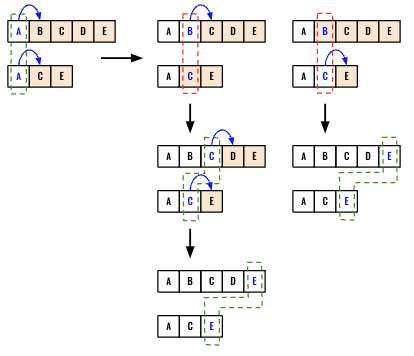Dynamic Programming - Longest Common Subsequence
All diagrams presented herein are original creations, meticulously designed to enhance comprehension and recall. Crafting these aids required considerable effort, and I kindly request attribution if this content is reused elsewhere.
Difficulty : Easy
DP
Problem
Given two strings text1 and text2, return the length of their longest common subsequence. If there is no common subsequence, return 0.
A subsequence of a string is a new string generated from the original string with some characters (can be none) deleted without changing the relative order of the remaining characters.
- For example,
"ace"is a subsequence of"abcde".
A common subsequence of two strings is a subsequence that is common to both strings.
Example 1:
1
2
3
Input: text1 = "abcde", text2 = "ace"
Output: 3
Explanation: The longest common subsequence is "ace" and its length is 3.
Example 2:
1
2
3
Input: text1 = "abc", text2 = "abc"
Output: 3
Explanation: The longest common subsequence is "abc" and its length is 3.
Example 3:
1
2
3
Input: text1 = "abc", text2 = "def"
Output: 0
Explanation: There is no such common subsequence, so the result is 0.
Solution
DFS/Recursive Solution
Solving this problem recursively would help to build the intuition for the dynamic programming approach. Let’s walk through an example first. In order to compare two strings we need two indexes i and j. Initially we will set both of them to 0. We will have just two separate scenarios in our dfs() function.
- If the letters match (
AandA) then we should next try to find common letters in the subsegment (highlighted in orange) (B,C,D,EandC,E). - If the letters do not match, then we will have two paths to take forward.
- Increment
i, however keepjthe same and compareC,D,EwithC,Ewhich eventually leads to finding bothC,E. - Increment
j, however keepithe same and compareB,C,D,EwithEwhich eventually leads to findingE.
- Increment
- Since both path after matching
Afinds different results (C,EvsE), we can take themaxof the outcome as the problem is about finding the longest common subsequence.
We can directly start with the dfs() function. Start with detecting the end of the starting. If at least one of the index is out of bound we can return 0 as no additional match can be found.
1
2
3
def dfs(i,j):
if i == len(text1) or j == len(text2):
return 0
As discussed, if there is a match we can increment both the index, call dfs() recursively and return by adding 1 as we just found a match.
1
2
if text1[i]==text2[j]:
return 1 + dfs(i+1,j+1)
Finally, if the letters do not match, we call dfs() twice and return the max.
1
2
else:
return max(dfs(i+1, j), dfs(i, j+1))
At the end, call and return the dfs() function.
1
return dfs(0,0)
This implementation will be Timed Out in LeetCode as it’s expecting a solution in O(n) Time Complexity.
Dynamic Programming Solution
We can use the very similar intuition from the dfs solution to implement using Dynamic Programming, however the only changes here are:
- Use loops instead of recursion
- Find the path from backward than forward.
As you see in the diagram below, this is a 2-Dimensional Dynamic Programming problem. We start with a cache to hold all the values. Since we are starting from backward we will have an additional column and row with 0 as the base condition.
Now very similar to the dfs solution, if we find a match we increment 1 by taking the value from the diagonal element (This is same as incrementing both i and j). (Red arrow)
If there is no match, we take the max from the diagonal positions (This is same as incrementing i and j separately and taking max from them). (Blue Arrow).
In case you are not very clear, please review the dfs solution.
Start by defining the cache to hold all the intermittent calculations. Initially we fill the entire cache with zeros.
Notice the outer loop is using
text1and inner loop is usingtext2.
1
cache = [[0 for _ in range(len(text2)+1) for _ in range(len(text1)+1)]]
Now have two nested loops.
1
2
for i in range(len(text1)-1,-1,-1):
for j in range(len(text2)-1,-1,-1):
If there is a match, take from the diagonal values.
1
2
3
4
for i in range(len(text1)-1,-1,-1):
for j in range(len(text2)-1,-1,-1):
if text1[i] == text2[j]:
cache[i][j] = 1 + cache[i+1][j+1]
If there is not a match then take the max.
1
2
3
4
5
6
for i in range(len(text1)-1,-1,-1):
for j in range(len(text2)-1,-1,-1):
if text1[i] == text2[j]:
cache[i][j] = 1 + cache[i+1][j+1]
else:
cache[i][j] = max(cache[i+1][j],cache[i][j+1])
Finally return the value from the [0][0] position.
1
return cache[0][0]
Final Code
Here is the full code.
DFS/Recursive
1
2
3
4
5
6
7
8
9
10
11
12
13
14
def longest_common_subsequence(text1: str, text2: str) -> int:
def dfs(i,j):
if i == len(text1) or j == len(text2):
return 0
if text1[i]==text2[j]:
return 1+ dfs(i+1,j+1)
else:
return max(dfs(i+1, j), dfs(i, j+1))
return dfs(0,0)
Dynamic Programming
1
2
3
4
5
6
7
8
9
10
11
12
def longest_common_subsequence(text1: str, text2: str) -> int:
cache = [[0 for _ in range(len(text2)+1)] for _ in range(len(text1)+1)]
for i in range(len(text1)-1,-1,-1):
for j in range(len(text2)-1,-1,-1):
if text1[i] == text2[j]:
cache[i][j] = 1 + cache[i+1][j+1]
else:
cache[i][j] = max(cache[i+1][j],cache[i][j+1])
return cache[0][0]

